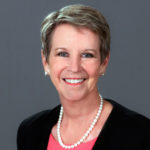As educators have sought more professional development — and, most urgently, training on educational technology — what for years has seemed like an obvious pairing has finally happened. Monday, the Association for Supervision and Curriculum Development and the nonprofit International Society for Technology in Education merged.
Technology’s rapid rise, especially during the pandemic, perhaps nudged the two closer to “combine their strengths and to make it even more seamless for [educators] to access the information that they need,” ASCD interim CEO Sandy Husk told Education Week recently. ASCD is a partner of SmartBrief.
ISTE will draw on the professional development, educator support and whole-child strengths of ASCD, while ASCD will take advantage of ISTE’s deep digital edtech knowledge and teaching practices. The organizations also will pool their efforts regarding the educational equity gap, broaden the community of life-changing educators, support the whole educator, start a joint nonprofit and lead the charge for reimagining education, according to ASCD and ISTE.
ISTE CEO Richard Culatta is heading the umbrella organization, and the groups will retain their separate identities, member services and annual conferences.
SmartBrief caught up with Culatta and Husk just after the merger was announced for more insight. The answers have been condensed and lightly edited for clarity.
SmartBrief: What gaps — what urgent needs — does this address in the education ecosphere?

Sandy Husk, ASCD: Too often as a superintendent, I would see that teachers and principals went to curriculum and assessment and supervision content places, and then they went to digital solutions and technology and innovation places. We can pull those together [now] because they logically belong together. Then it is much easier to provide service to our members.
Also, we’re wanting the whole ecosystem. [Teachers would say,] “I don’t know how am I going to use this digital solution separate from my science lesson,” or “How can I teach science without ever using any digital or tech solution?” It just seems like a really nice way to pull this together in a professional development space.

Richard Culatta, ISTE: In this post-COVID world, there is a huge amount of technology and infrastructure now available to support learning. There’s also a dramatically increased set of challenges that need to be solved — some created from the pandemic, frankly; some that always existed. But we’re paying more attention to them now because the pandemic exposed them. What we hope to do with this [merger] is bring together the communities that really look at problem-solving — particularly problem-solving using technology in smart ways — with the people who are really leading our education system across the country and provide them with some new approaches, some new tools that really merge together what has been too siloed for too long.
SB: What will members notice right away because of the merger?
Husk: Folks that are either in the affiliate or the ambassador groups are already realizing they now have a new, potential partner in that community. People are finding logical ways to reach out to each other and say, “Hey, maybe this is an opportunity for us to combine some of our events or at least start to become partners.”
The “can I get a discount?” decisions haven’t been made, but I think that’s a fairly logical thing for the new umbrella organization to look at. And already our events teams for both organizations are talking to each other and learning from each other. Even before we knew about the merger, we’ve done some partnership on common themes through our publications, and I’m sure that will continue as well.
Culatta: Some of the things that they’ll notice is some cross-pollination of topics of conversation. We’re intentionally not going to shove both of the memberships together; we think it’s important that they keep their unique identity and culture. But we are going to immediately start looking at ways that we can hear some different voices that we haven’t heard on both sides.
Shortly after that, you will see some opportunities for people who are ASCD members to become more engaged and involved with some of the ISTE membership community and vice versa. Again, that will be optional. We’re not going to push people to do that, but we’re going to make it very easy to start having some cross-cutting conversations.
SB: Some educators have resisted technology, perhaps due in part to rushed or bad experiences or lack of training, especially during the pandemic. How will this new organization aim to nurture a new mindset about adopting and using technology?
Husk: I think you always have early adopters. So as technology has become more and more prevalent and available to the instruction side of school districts, you’ve got those folks that weren’t kicking and screaming but were very, very enthusiastic. And not only are they early adopters, but they become the energy behind getting some of the rest of us enthusiastic about that level of learning.
Some districts may have been early adopters by necessity because they’re so spread out. We showed that they could offer certain kinds of courses they couldn’t bring into all different parts of the state. So I think you’ll see that kind of thing continuing.
Technology really does work for some students, but I personally wouldn’t recommend it as an exclusive way to instruct all students. But I do think that this is the way of the future. We would have never thought about doing a Zoom call or a Google Meet call for an interview. I just think it’s going to give more options, and the needs should dictate the way that we give those choices.
Culatta: First of all, I absolutely cannot blame anyone — any educators– for being hesitant about using technology. Unfortunately, in many of the schools across the country during the pandemic, technology was purchased and distributed with very little thought to helping make sure teachers were prepared, to making sure there was a vision set for how the technology was going to be used in support of learning. I’d be skeptical and frustrated too.
The good news is that we know that when technology is used right — when it is used in alignment with learning research, when it is used aligned with good principles — what you actually see are very powerful results. [We see] increased engagement, students feeling more included, teachers feeling less overwhelmed with logistical tasks. So the goal is to clearly call out the strategies that work, and also be blunt about the approaches that don’t, so we can stop the practices that are not helping kids.
For example, there are schools that are essentially taking traditional approaches — worksheets, multiple-choice tests, strategies that we know aren’t very effective — and digitizing them, moving them into a virtual format and saying, “Now we’re doing technology well.” We need to call that out, and we need to do it in a way that doesn’t feel like anybody’s getting thrown under the bus. If you’re not calling out the practices that don’t work, then it feels like an endorsement, and people think that that’s the way it should be.
So, while we need to be respectful about it, we need to be clear: There are certain approaches for using technology that do not support effective student learning. We’ve got to say it and then, of course, say, “Here are your other options and other paths if you want to make better decisions.”
SB: The whole child has always been ASCD’s guiding light — laying out the many ways educators grow and advocate so they can provide the very best for students. That often means addressing intangibles. Tech is very tangible. How do you see it blending with the whole-child view?
Husk: When you think about the child, in some ways, it’s acknowledging that reading, writing, math, science are and will always be important. But there’s a whole other level of social skills and how to study and how to set goals and then how to be disciplined and following your goals. How to ask people questions when you don’t understand. Whether you call it college/career-ready or social-emotional learning, those are all very important things that we develop over time. So whether we’re officially teaching it through a curriculum that’s adopted, or it becomes a part of the norm in the culture, that will always be there.
Technology can be helpful around equity and access. The bigger equity issue is access to the internet. That is so huge. And in my opinion, there’s no reason not to solve it . As a nation we should be able to come up with a solution. Expanding the community can not only double our impact but also create an opportunity and energy about getting other organizations to the table. And I see that as a very positive result of the merger also.
SB: This union has been a long time coming. Why has no one stepped into this space before and created this type of association? What makes now the right time to do it?
Culatta: I think this is something that, for many years, people said, “That’s probably the right thing to do.” The reality, though, was that until the pandemic happened, there was so much momentum for the status quo [that] it would have been hard to get support for something like this.
Now, status quo has, for better or worse, been blown to bits. We have made the conditions right to rebuild [education] in a different way — to not go back to where we were before but actually try to think about what it should look like.
I hope this is the catalyst for other organizations and groups to say, “Hey, we’re in a post-COVID world. Things look different. Are we set up to serve the needs of teachers and leaders today? Or are we still set up to serve the needs of teachers and leaders from three years ago?”
I think if we ask ourselves that question, there are a lot of organizations that will rethink and realign what they’re going to look like in the future.
SB: ISTE has long espoused the importance of community. It’s your cornerstone. How important is community now in education, and how will you nurture it as you bring these two organizations together?
Culatta: Community really is the secret sauce of ISTE. Right now, there’s such a great need out in the field for teachers to not feel like they’re going it alone, for leaders to not feel like they’re going it alone. We don’t have all the solutions, but we can get pretty close when we bring enough of the right people into the conversation.
That’s what I feel is our most important task: to provide a convenient, safe supportive space for educators and education leaders to share what their problems are and what solutions they have found in order to help spread good ideas. There is no shortage of amazing solutions in education. The challenge is, we don’t know about a lot of them. In some cases, they’re happening at a school right down the street or in the classroom right next to ours. And we don’t know about it.
Part of the responsibility of being a learning leader is sharing what’s working and sharing where we need help. And that’s what we hope we can do through the community strategies that we have at ISTE and ASCD.
Kanoe Namahoe is the editorial director for SmartBrief Education and Business Services. Contact her at [email protected].
Diane Benson Harrington is an education writer at SmartBrief. Reach out to her via email, Twitter or LinkedIn.
Opinions expressed by SmartBrief contributors are their own.
_________________________
Subscribe to SmartBrief’s FREE email ASCD and EdTech newsletters to see the latest hot topics in education. They’re among SmartBrief’s more than 250 industry-focused newsletters.
